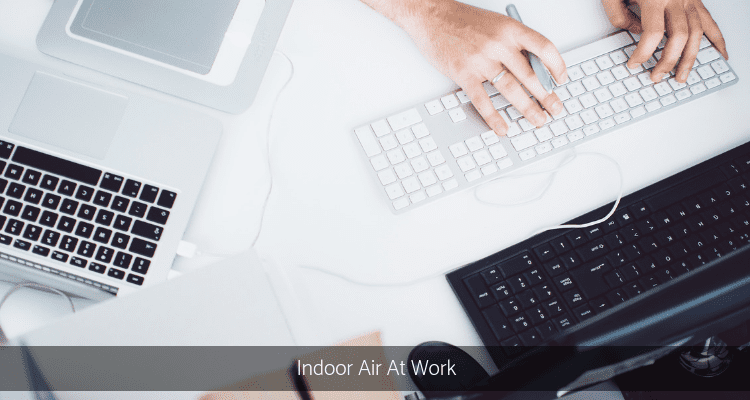We spend a considerable part of our lives working in tightly sealed air-conditioned spaces, without giving much thought to the office air quality.
Since office windows are rarely opened, the office air quality is often not as fresh as it should be. Electronic devices such as computers, printers, copiers, and even the telephone on your desk harbour bacteria, dust and other common health triggers. Chemical sprays used to clean desk tops, windows and carpets worsen the situation. It is not uncommon for potential mould to infest the office storage and other damp spaces.
Poor office air quality should be of great concern for businesses because it has a direct affect on employee health. Poor indoor air quality can lead to sneezing, coughing, dizziness, fatigue, headaches, nasal congestion, skin allergies, sore throat, nausea and eye irritations.

Investing in the indoor office environment is not just about improving the well-being of employees and visitors to your office, it can significantly improve the bottom-line as well. A healthier workplace improves workforce comfort, increases employee productivity and reduces absenteeism. Healthier, happier employees deliver better results!
Reduce Exposure to Indoor Pollutants
As a business owner or manager of an office space, there is a lot you can do to reduce and remove sources of indoor pollutants and reduce adverse health effects. Here are a few suggestions:
- Smoking should not be allowed both inside the office and within a metre of the entrance. The designated smoking area should be located a sufficient distance from office doors, windows and ventilation systems.
- Place large door mats at the office entrance to reduce the amount of dust, pesticides, pet dander and other pollutants that are carried in stuck on people’s shoes.
PRODUCT:
Door Mats
Choosing the right door mat will help reduce the dust entering your house. To help you out, we have done some research and found these that will do the job.

- If you are moving into a new office, you may want to avoid wall-to-wall carpeting. If you do have carpeted areas, use vacuum cleaners with HEPA filter and power head.
- Where possible clean the dust in the office with a damp cloth or mop.
- Air fresheners are popular in offices, but they add to the chemical air contaminants. STOP using air fresheners.
- Use cleaning products with natural ingredients. Avoid products with chlorine, ammonia or bleach.
- Check any seepage from plumbing pipes, toilets, dishwashers, walls and windows and dry immediately to prevent potential mould growth.
- Indoor plants are a great way to splash some colour in the office space, and naturally cleanse the air, regulate humidity and moisture. NASA and Dr B.C. Wolverton discovered that house plants remove and or reduce air pollutant contaminants and in turn improve indoor air quality.
PRODUCT:
Hire an Indoor Plant for your Office
If your work space is particularly poorly lit or you’d like a particular plant in your office that needs more light than is available, we can work around this by regularly rotating plants from your work space to the nursery to ensure they remain healthy and lush. Check the options available here at The Garden Path.

- Do not use pesticides inside the office, instead choose non-toxic pest control methods.
- Use low VOC paint when renovating your office.
- Ensure regular maintenance of the office heating, ventilating and air conditioning systems. According to WHO (2008) moisture-related heating, ventilation and air-conditioning components such as cooling coils and humidification systems, when poorly maintained, can be sources of microbiological contaminants that cause adverse health effects in occupants. Change air filters in these systems regularly.
- If possible, open office windows for natural ventilation.
- Use furniture made from solid wood. Alternatively, apply water-based sealant to pressed wood furniture to prevent chemicals present in the pressed wood from polluting the indoor air.
If the problem persists even after you have identified and remedied obvious sources of indoor air pollutants, seek outside help such as local or state health departments or consultants in industrial hygiene and Building Biology.
What initiatives has your office taken to improve the indoor air quality?
Towards healthier living Carol Parr ♥
As Building Biologists, we have acquired knowledge of adverse health effects and recommend effective strategies to reduce occupants’ exposure by eliminating and controlling as many sources of pollutants in order to create healthy indoor living environments that are as exposure-free and natural as practically possible.
References:
WorldHealth Organisation. (2009). WHO Guidelines for Indoor Air Quality, Dampnessand Mould. (Online). Available: http://www.euro.who.int/__data/assets/pdf_file/0017/43325/E92645.pdf[6 August, 2015]
Wolverton,Dr B.C. 1996, How to Grow Fresh Air: 50 Houseplants that Purify Your Home orOffice, Weidenfeld & Nicholson, London.
Centre For Disease Control and Prevention. (2009). CDC – NCEH – Healthy Housing Reference Manual – Chapter 5: Indoor Air Pollutants and Toxic Materials. [online] Available at: https://www.cdc.gov/nceh/publications/books/housing/cha05.htm [Accessed 23 Dec. 2018].
Author
-
We’re glad you’re here. We’re Carol and Tony, founders of one of the longest running Healthy Home Blogs in the world, Mitey Fresh Australia. We’ve been on this journey for the last 25 years and are passionate about helping families sift through health hazards and triggers like allergens, mould, water damage, chemicals and EMFs, to get clarity about what’s toxic and what’s not so they can create a healthy and happy home for their family they love. Each month, people visit this blog seeking focus on the health and wellbeing of their loved ones, sustainable and effective practice tips and guides, to help create and manage healthier indoor spaces, improve the built environment that is pleasing to the senses and support healthy living and nature, every day. Starting this blog was to help change people’s lives, one family at a time, and we can’t wait to share how its allowed us to stand next to you and show you how interpreting these synergies between buildings and the environment they are built in will impact upon the health and well-being of those who occupy them. Find out more about Healthy Homes and what this blog can do for you!





